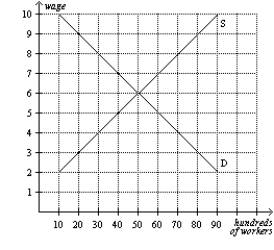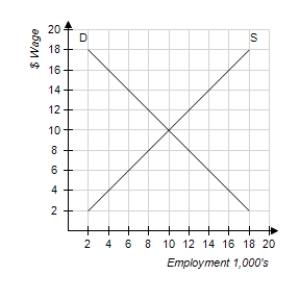A) 0 workers.
B) 2,000 workers.
C) 4,000 workers.
D) 5,000 workers.
Correct Answer

verified
Correct Answer
verified
Multiple Choice
Minimum-wage laws
A) create unemployment.
B) do not apply in states with right-to-work laws.
C) affect highly-educated workers more than high school dropouts.
D) cause labor shortages,which further raise wages above equilibrium.
Correct Answer

verified
Correct Answer
verified
Multiple Choice
Figure 28-3  -Refer to Figure 28-3.At the equilibrium wage,how many workers are unemployed?
-Refer to Figure 28-3.At the equilibrium wage,how many workers are unemployed?
A) 0
B) 4,000
C) 5,000
D) 8,000
Correct Answer

verified
Correct Answer
verified
Multiple Choice
Minimum-wage laws are most likely to affect the wages paid to
A) teenagers.
B) people with advanced technical training.
C) people who are self-employed.
D) union members.
Correct Answer

verified
Correct Answer
verified
Multiple Choice
Figure 28-3  -Refer to Figure 28-3.If the government imposes a minimum wage of $8,then how many workers will be employed?
-Refer to Figure 28-3.If the government imposes a minimum wage of $8,then how many workers will be employed?
A) 3,000
B) 4,000
C) 5,000
D) 7,000
Correct Answer

verified
Correct Answer
verified
Multiple Choice
An increase in the minimum wage
A) reduces structural unemployment.
B) reduces frictional unemployment,
C) increases structural unemployment.
D) increases frictional unemployment.
Correct Answer

verified
Correct Answer
verified
Multiple Choice
Figure 28-4
 -Refer to Figure 28-4.If 8,000 workers are unemployed,then the minimum wage must be
-Refer to Figure 28-4.If 8,000 workers are unemployed,then the minimum wage must be
A) $6
B) $8
C) $12.
D) $14.
Correct Answer

verified
Correct Answer
verified
Multiple Choice
Figure 28-4
 -Refer to Figure 28-4.If the government imposes a minimum wage of $4,how many workers will be unemployed?
-Refer to Figure 28-4.If the government imposes a minimum wage of $4,how many workers will be unemployed?
A) 0
B) 4,000
C) 6,000
D) 12,000
Correct Answer

verified
Correct Answer
verified
Multiple Choice
Figure 28-4
 -Refer to Figure 28-4.If the government imposes a minimum wage of $12,how many workers will be unemployed?
-Refer to Figure 28-4.If the government imposes a minimum wage of $12,how many workers will be unemployed?
A) 0
B) 2,000
C) 4,000
D) 10,000
Correct Answer

verified
Correct Answer
verified
Multiple Choice
If the minimum wage is currently above the equilibrium wage,then a decrease in the minimum wage
A) increases both the quantity demanded and the quantity supplied of labor.
B) decreases both the quantity demanded and the quantity supplied of labor.
C) increases the quantity of labor demanded but decreases the quantity of labor supplied.
D) decreases the quantity of labor demanded but increases the quantity of labor supplied.
Correct Answer

verified
Correct Answer
verified
Multiple Choice
Figure 28-3  -Refer to Figure 28-3.If the government imposes a minimum wage of $4,how many workers will be employed?
-Refer to Figure 28-3.If the government imposes a minimum wage of $4,how many workers will be employed?
A) 3,000
B) 4,000
C) 5,000
D) 7,000
Correct Answer

verified
Correct Answer
verified
Multiple Choice
Figure 28-4
 -Refer to Figure 28-4.If the government imposes a minimum wage of $10,how many workers will be unemployed?
-Refer to Figure 28-4.If the government imposes a minimum wage of $10,how many workers will be unemployed?
A) 0
B) 2,000
C) 4,000
D) 8,000
Correct Answer

verified
Correct Answer
verified
Multiple Choice
Figure 28-3  -Refer to Figure 28-3.At the equilibrium wage,how many workers are employed?
-Refer to Figure 28-3.At the equilibrium wage,how many workers are employed?
A) 0
B) 1,000
C) 5,000
D) 9,000
Correct Answer

verified
Correct Answer
verified
Multiple Choice
Figure 28-4
 -Refer to Figure 28-4.If the government imposes a minimum wage of $6,how many workers will be unemployed?
-Refer to Figure 28-4.If the government imposes a minimum wage of $6,how many workers will be unemployed?
A) 0
B) 4,000
C) 8,000
D) 12,000
Correct Answer

verified
Correct Answer
verified
Multiple Choice
An increase in the minimum wage
A) increases both the quantity demanded and the quantity supplied of labor.
B) decreases both the quantity demanded and the quantity supplied of labor.
C) increases the quantity of labor demanded but decreases the quantity of labor supplied.
D) decreases the quantity of labor demanded but increases the quantity of labor supplied.
Correct Answer

verified
Correct Answer
verified
Multiple Choice
Figure 28-4
 -Refer to Figure 28-4.If 4,000 workers are unemployed,then the minimum wage must be
-Refer to Figure 28-4.If 4,000 workers are unemployed,then the minimum wage must be
A) $6
B) $8.
C) $12.
D) $14.
Correct Answer

verified
Correct Answer
verified
Multiple Choice
Minimum-wage laws can keep wages
A) above equilibrium and cause a surplus of labor.
B) above equilibrium and cause a shortage of labor.
C) below equilibrium and cause a surplus of labor.
D) below equilibrium and cause a shortage of labor.
Correct Answer

verified
Correct Answer
verified
Multiple Choice
Which of the following is not correct?
A) Frictional unemployment results from the process of matching workers and jobs.
B) Structural unemployment results when the number of jobs is insufficient for the number of workers.
C) Minimum wages are the predominant reason for unemployment in the U.S.economy.
D) When a minimum-wage law forces the wage to remain above the level that balances supply and demand,it raises the quantity of labor supplied and reduces the quantity of labor demanded compared to the equilibrium level.
Correct Answer

verified
Correct Answer
verified
Multiple Choice
Minimum wages create unemployment in markets where they create a
A) shortage of labor.Minimum wage laws are not the predominant reason for unemployment in the U.S.
B) shortage of labor.Minimum wage laws are the predominant reason for unemployment in the U.S.
C) surplus of labor.Minimum wage laws are not the predominant reason for unemployment in the U.S.
D) surplus of labor.Minimum wage laws are the predominant reason for unemployment in the U.S.
Correct Answer

verified
Correct Answer
verified
Showing 21 - 39 of 39
Related Exams